Geoblog.pl  bzmot
bzmot  Podróże
Podróże  Łosie okrakiem przez Amerykę - V2.0 - The Moose Do America Again - Click Here!!!
Łosie okrakiem przez Amerykę - V2.0 - The Moose Do America Again - Click Here!!!  Bez pracy nie ma kołaczy
Bez pracy nie ma kołaczy
 bzmot
bzmot  Podróże
Podróże  Łosie okrakiem przez Amerykę - V2.0 - The Moose Do America Again - Click Here!!!
Łosie okrakiem przez Amerykę - V2.0 - The Moose Do America Again - Click Here!!!  Bez pracy nie ma kołaczy
Bez pracy nie ma kołaczy 
W Trinidadzie na kilka dni zatrzymało nas duże zlecenie, które chcieliśmy w spokoju skończyć. Z przewodnika wynikało, że Trinidad – nic ciekawego. Ale pierwsze wrażenie całkiem korzystne. Upał jak trza, a od upału chronią kolonialne podcienia, którymi można pół „starówki” przejść. Całkiem ładne, kolorowe kolumienki. Za to parczek na głównym placu to istna dżungla i to pięknie oświetlona w nocy. Za dnia jest pustawo, ale popołudniu wokół placu krążą motory. Część z nich to taksówki z pasażerami, bo samochodowych prawie nie ma. Ale większość to lansująca się uroczo młodzież. Daleko w małym miasteczku nie zajadą, więc co i rusz te same twarze wracają. I to twarze całkiem powabne. Rysy mają trochę hawajskie, karnację mocno opaloną. O tym, że wciąż jesteśmy w Boliwii przypominają tylko nieliczne cholity serwujące sok z pomarańczy. Panoramę etniczną uzupełniają Menonici. Część to potomkowie niemieckich kolonizatorów, którzy od wielu pokoleń tu siedzą, ale niektóre osady są ponoć całkiem nowe. Słyszałam, że zakładają je Amisze z USA, ale nie wiem, czy to prawda. Chociaż jeden facet w ogrodniczkach i słomianym kapeluszu to faktycznie wyglądał jak amerykański farmer z westernu.
Po skończeniu pracy chcieliśmy popłynąć sobie w kilkudniowy rejs łódką towarową po rzece Mamoré. Pojechaliśmy więc (mototaksówką) do wskazanego w przewodniku portu, a tam, owszem, smażalnia jest i letnicy, ale gdzie łódki? A bo towarowe to z innego portu odpływają. Dobra, wieź, pan. Port wygląda tak, że stoją jakieś leciwe wehikuły, ale nabrzeża brak, nie mówiąc o jakimkolwiek biurze czy tablicy informacyjnej. Wokół żywej duszy, na moje wołania nikt nie odpowiada. Brzeg ma skarpę kilkumetrową, ze stromym zejściem po błocie. Trapu nie ma. Zresztą co się będę na statek włamywać. Wreszcie nadchodzi jakiś facet z workiem ryżu. Nie, nie wypływamy dzisiaj i chyba nikt inny, bo święto. Tankowiec (cisterna) chyba najprędzej, o, tamten. Z tankowcem komunikacja też ograniczona. Jacyś goście się uwijają na pokładzie, wołam coś do nich z brzegu, oni mi coś odmachują. Wreszcie jeden robi z deski trap i zaprasza, żebym sobie weszła i poszukała szefa. Statek jest malutki, ale zanim trafiam na kapitana, niechcący cały zwiedzam. Już mi się odechciewa wycieczki, taki syf. Śpi się w kajucie, ale chyba z marynarzami, bo wszystko zajęte. To już lepszy byłby ten stateczek zastawiony oranżadą, bo ma trzcinowy daszek i śpi się na pokładzie na workach z ryżem. Ale nie wiadomo, kiedy wypływa. Wreszcie machamy na to ręką i postanawiamy rejs po dużej rzece odłożyć na kiedy indziej. A z powrotem w mieście czeka na nas parada z okazji dnia niepodległości.
In Trinidad we were tied up by a big project that we needed to complete in peace. The guidebook claimed Trinidad is nothing interesting. But our first impression was quite cool. The weather is as hot as needed, and there are colonial arcades to shield you from too much sun. You can get thru half of the “old town” in their shade. Quite pretty colorful columns lining the streets. And the park on the main square is a real jungle, beautifully illuminated at night. During the day, it’s quite empty but in the evening it fill with motorbikes cruising to and thru. Some are taxis with passengers, as there are hardly any cars in town. Most, however, are young people putting on the Ritz. They won’t go far in a small town like that, so you see the same faces all the time. And quite pretty faces, too. They look Hawaiian, just a shade darker. The few cholitas selling orange juice are the only thing to remind you we’re still in Bolivia. The ethnic panorama is complemented by Menonites. Some are descendants of German colonizers that have been here for generations, but apparently some settlements are quite new. I heard they are founded by the Amish from the US but I’m not sure that’s true. Still, one guy wearing dungarees and a straw hat guy did look like an American farmer from Western movies.
Once our job was done, we wanted to take a several days’ cargo boat cruise down the Mamoré river. So we took a mototaxi to the port indicated by the guidebook, and there is a fish restaurant alright, and some holiday makers but where are the boats? Oh, the cargo ones leave from another port. Ok, off we go. Picture yourself the port: a couple of old boats, no wharf, not to mention an office or any kind of information board. No one in sight, nobody responding to my noisy hellos. The bank is several meters high, with a steep path down the mud. No gangway. Anyway, I’m not breaking into a boat. At last, a guy with a big bag of rice appears. No, we’re not sailing out today and nobody else is, it’s a holiday. The tanker (cisterna) will leave first, see, the one over there. There are some guys bustling about on the deck, I call them and they wave something back, no idea what it means. Then one of them makes a gangway of a plank and invites me in to look for the boss myself. The boat is small but before I find the captain, I get to visit it all accidentally. And I no longer feel up to the ride, it’s pretty disgusting. You sleep in a cabin, but probably share it with sailors as I didn’t see any vacancies. I’d prefer the little boat filled with lemonade bottles as it has a reed roof and you sleep on the deck on rice bags. But they don’t know when they’re getting out. Finally we decide to take a rain check. And back in town we’re in for an Independence Day parade.
Po skończeniu pracy chcieliśmy popłynąć sobie w kilkudniowy rejs łódką towarową po rzece Mamoré. Pojechaliśmy więc (mototaksówką) do wskazanego w przewodniku portu, a tam, owszem, smażalnia jest i letnicy, ale gdzie łódki? A bo towarowe to z innego portu odpływają. Dobra, wieź, pan. Port wygląda tak, że stoją jakieś leciwe wehikuły, ale nabrzeża brak, nie mówiąc o jakimkolwiek biurze czy tablicy informacyjnej. Wokół żywej duszy, na moje wołania nikt nie odpowiada. Brzeg ma skarpę kilkumetrową, ze stromym zejściem po błocie. Trapu nie ma. Zresztą co się będę na statek włamywać. Wreszcie nadchodzi jakiś facet z workiem ryżu. Nie, nie wypływamy dzisiaj i chyba nikt inny, bo święto. Tankowiec (cisterna) chyba najprędzej, o, tamten. Z tankowcem komunikacja też ograniczona. Jacyś goście się uwijają na pokładzie, wołam coś do nich z brzegu, oni mi coś odmachują. Wreszcie jeden robi z deski trap i zaprasza, żebym sobie weszła i poszukała szefa. Statek jest malutki, ale zanim trafiam na kapitana, niechcący cały zwiedzam. Już mi się odechciewa wycieczki, taki syf. Śpi się w kajucie, ale chyba z marynarzami, bo wszystko zajęte. To już lepszy byłby ten stateczek zastawiony oranżadą, bo ma trzcinowy daszek i śpi się na pokładzie na workach z ryżem. Ale nie wiadomo, kiedy wypływa. Wreszcie machamy na to ręką i postanawiamy rejs po dużej rzece odłożyć na kiedy indziej. A z powrotem w mieście czeka na nas parada z okazji dnia niepodległości.
In Trinidad we were tied up by a big project that we needed to complete in peace. The guidebook claimed Trinidad is nothing interesting. But our first impression was quite cool. The weather is as hot as needed, and there are colonial arcades to shield you from too much sun. You can get thru half of the “old town” in their shade. Quite pretty colorful columns lining the streets. And the park on the main square is a real jungle, beautifully illuminated at night. During the day, it’s quite empty but in the evening it fill with motorbikes cruising to and thru. Some are taxis with passengers, as there are hardly any cars in town. Most, however, are young people putting on the Ritz. They won’t go far in a small town like that, so you see the same faces all the time. And quite pretty faces, too. They look Hawaiian, just a shade darker. The few cholitas selling orange juice are the only thing to remind you we’re still in Bolivia. The ethnic panorama is complemented by Menonites. Some are descendants of German colonizers that have been here for generations, but apparently some settlements are quite new. I heard they are founded by the Amish from the US but I’m not sure that’s true. Still, one guy wearing dungarees and a straw hat guy did look like an American farmer from Western movies.
Once our job was done, we wanted to take a several days’ cargo boat cruise down the Mamoré river. So we took a mototaxi to the port indicated by the guidebook, and there is a fish restaurant alright, and some holiday makers but where are the boats? Oh, the cargo ones leave from another port. Ok, off we go. Picture yourself the port: a couple of old boats, no wharf, not to mention an office or any kind of information board. No one in sight, nobody responding to my noisy hellos. The bank is several meters high, with a steep path down the mud. No gangway. Anyway, I’m not breaking into a boat. At last, a guy with a big bag of rice appears. No, we’re not sailing out today and nobody else is, it’s a holiday. The tanker (cisterna) will leave first, see, the one over there. There are some guys bustling about on the deck, I call them and they wave something back, no idea what it means. Then one of them makes a gangway of a plank and invites me in to look for the boss myself. The boat is small but before I find the captain, I get to visit it all accidentally. And I no longer feel up to the ride, it’s pretty disgusting. You sleep in a cabin, but probably share it with sailors as I didn’t see any vacancies. I’d prefer the little boat filled with lemonade bottles as it has a reed roof and you sleep on the deck on rice bags. But they don’t know when they’re getting out. Finally we decide to take a rain check. And back in town we’re in for an Independence Day parade.
Komentarze (1)

 PA!wel - 2007-08-07 22:16
PA!wel - 2007-08-07 22:16Motorkowe taksóweczki to mieliśmy nieźle opracowane w Kambo - wozili tam nas razem z wypchanymi plecakami (osiemdziesiątki) - tak więc sobie możecie wyobrazić ;)
Napiszcie ze 2 słowa o tym zleceniu bo ciekawość zżera ;)
Napiszcie ze 2 słowa o tym zleceniu bo ciekawość zżera ;)





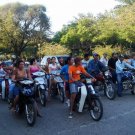
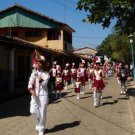
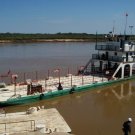
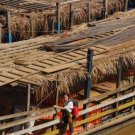
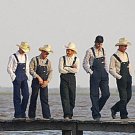

 Zasoby:
Zasoby: 






